Henini M. Handbook of Self Assembled Semiconductor Nanostructures for Novel devices in Photonics and Electronics
Подождите немного. Документ загружается.


Probing and Controlling the Spin State of Single Magnetic Atoms in an Individual Quantum Dot 449
Another way to reduce the non-radiative losses was to introduce the magnetic atoms in the
quantum dots barriers. This has been realized for CdSe dots embedded in ZnMnSe barriers by
Seufert et al . [18] . In this system, the interaction between the confi ned exciton and the magnetic
ions is due to the spread of the wave function in the barriers and to a small diffusion of the mag-
netic atoms in the quantum dots. In these diluted magnetic semiconductor (DMS) structures, the
response time of the paramagnetic Mn spin was extracted from the transient spectral shift of the
photoluminescence caused by the dynamical spin alignment of magnetic ions incorporated into
the crystal matrix. The formation of a ferromagnetically aligned spin complex was demonstrated
to be surprisingly stable as compared to bulk magnetic polaron [19, 20] , even at elevated temper-
ature and high magnetic fi elds. The photoluminescence of a single electron–hole pair confi ned
in one magnetic QD, which sensitively depends on the alignment of the magnetic ions spins,
allowed measurement of the statistical fl uctuation of the magnetization on the nanometre scale.
Quantitative access to statistical magnetic fl uctuations was obtained by analysing the linewidth
broadening of the single dot emission. This all-optical technique allowed a magnetic moment of
about 100 μ
B
to be addressed and changes in the order of a few μ
B
[21–23] to be resolved.
A huge effort has also been done to incorporate magnetic ions in chemically synthesized II–VI
nanocrystals [24] . The incorporation of the magnetic impurities is strongly dependent on the
growth conditions and controlled by the adsorption of impurities on the nanocrystal surface
during growth [25] . The doping of nanocrystals with magnetic impurities also leads to interest-
ing magneto-optical properties [26] but once again, in these highly confi ned systems, the trans-
fer of confi ned carriers to the Mn electronic levels strongly reduces their quantum effi ciency
and prevents the optical study of individual Mn-doped nanocrystals. However, by looking to
MCD absorption spectra it is possible to observe a giant excitonic Zeeman splitting and to deduce
directly the sp–d exchange interaction [27] .
CdTe/ZnTe self-assembled QDs usually present an emission energy below the internal transi-
tion of the Mn atom. The incorporation of magnetic atoms is then possible without losing the
good optical properties of these QDs. Up to now, however, all the experimental studies on these
diluted magnetic QDs were focused on the interaction of a single carrier spin with its paramag-
netic environment (large number of magnetic atoms) [28] . We will see that CdTe/ZnTe quantum
dot structures doped with a low density of Mn atoms allow the optical control of spin states of a
single magnetic ion interacting with a single electron–hole pair or a single carrier.
14.2 II–VI diluted magnetic semiconductors quantum dots
14.2.1 Carrier–Mn coupling
Carrier–Mn coupling was mostly studied in bulk DMS made of II–VI semiconductors in which
Mn impurities were introduced (see the review papers [29, 30] ). These semiconductors are
formed with a cation from column II (Zn, Cd or Hg) and an anion from column VI (Te, Se, S and
more recently even O). These compounds assume the zinc-blende structure or, for the most ionic
ones, the closely related wurtzite structure. Manganese impurities have the d
5
electronic confi g-
uration and substitute the cations up to 100%. An important point is that Mn substitutes the
column II cation as an isoelectronic impurity – by contrast to the acceptor character observed
in GaAs and similar III–Vs [31, 32] . The Mn ground state is 6S (or 6A1 in cubic or hexagonal
symmetry), introducing localized, isotropic spins with S 5/2. If not interacting, these localized
spins follow Maxwell–Boltzmann statistics, resulting in a magnetization M induced by an applied
fi eld H at temperature T given by a Brillouin function of H / T :
MxNg B
gH
kT
Mn B
Mn B
B
052
0
5
2
5
2
()
()
μ
μμ
/
⎛
⎝
⎜
⎜
⎜
⎜
⎞
⎠
⎟
⎟
⎟
⎟
(14.1)
where x is the proportion of cations substituted by Mn, N
0
the density of cations in the zinc-
blende or wurtzite structure, g
(Mn)
2 (to a good approximation) is the Mn Lande factor, μ
B
is the
CH014-I046325.indd 449CH014-I046325.indd 449 6/27/2008 4:29:47 PM6/27/2008 4:29:47 PM
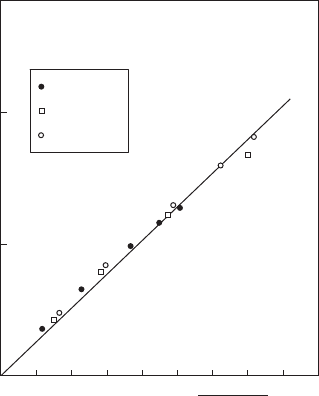
450 Handbook of Self Assembled Semiconductor Nanostructures for Novel Devices in Photonics and Electronics
Bohr magneton, and k
B
the Boltzmann constant. This would apply for non-interacting spins. In
the actual material, antiferromagnetic “ superexchange ” interactions appear as soon as the Mn
density is not vanishingly small. These interactions result in a reduction of the magnetization:
this is quantitatively described by using a “ modifi ed Brillouin function ” where x is replaced by
a number of free spins x
eff
, and the argument is H /( T T
AF
). The values of the two phenomeno-
logical parameters x
eff
and T
AF
are experimentally well documented in the most usual DMSs, such
as Cd
1
x
Mn
x
Te [33] . The number of free spins has a direct physical meaning: nearest-neighbour
Mn pairs are blocked antiparallel by the strong superexchange interaction – it can be calculated
from statistics over Mn pairs and clusters either in the homogeneous material [34, 35] , or even at
an interface with the non-magnetic semiconductor [36] . The description by a modifi ed Brillouin
function has proven to be very effi cient at moderately low temperatures (1 to 30 K), moderate
fi eld (up to 5 T), and composition up to x 0.2 [33] . A spin glass behaviour appears at higher
Mn contents in this temperature range, and at lower temperature even for a low Mn content. At
higher temperatures or higher fi eld nearest-neighbour pairs are no longer blocked antiparallel.
It was recognized early that the key property of a DMS is the strong coupling between the bands
of the semiconductor (conduction band and, even more strongly, valence band) and the localized
spins. Optical spectroscopy around the band gap reveals the so-called “ giant Zeeman effect ” , with
a spin splitting proportional to the Mn magnetization [37] . Several studies have demonstrated
this proportionality and measured the strength of the coupling [38] (see Fig. 14.1 ).
100
Zn
1x
Mn
x
Te
50
E (meV)
0.0 0.05
M
m
x 0.031
x 0.071
x 0.095
9 μ
B
mZnMnTe
Figure 14.1 Splitting of the free exciton line. The straight line is the theoretical dependence calculated for
N
0
( α – β ) 1.29 eV (from A. Twardowski et al. , Solid State Com., 50 , 509 (1984)).
As a result, magneto-optical spectroscopy is now a very sensitive method for measuring locally
the magnetization of the Mn system. For example, it was applied [33] to measure the diffusion
of Mn across a (Cd,Mn)Te–CdTe interface during the growth by molecular beam epitaxy (MBE).
Actually, the method is quite direct in semiconductors with intermediate values of the band gap
width (tellurides, selenides). In wide band gap semiconductors, ex-citonic effects are important
so that the splitting directly measured on the spectra is not proportional to the spin splitting of
the bands [39] . Altogether, this excellent knowledge of the magnetic properties in (electrically)
undoped II–VI DMSs, and of the coupling between the localized spins and the conduction/
valence band, constitutes a very fi rm basis for the further studies described below.
CH014-I046325.indd 450CH014-I046325.indd 450 6/27/2008 4:29:47 PM6/27/2008 4:29:47 PM
Probing and Controlling the Spin State of Single Magnetic Atoms in an Individual Quantum Dot 451
14.2.2 CdTe:Mn/ZnTe quantum dots
The CdTe/ZnTe QDs samples used in this study are grown by atomic layer epitaxy (ALE) with a
deposition of six monolayers of CdTe on a ZnTe buffer. One should note that the vapour pressure
above the column II or column VI elements in an ultra-vacuum chamber is much higher than
above their compounds. As a result, stable surfaces are obtained under a fl ux of either the cation
or the anion species – another difference with the III–Vs. That implies that (ALE) is feasible [40] ,
as well as MBE under both cation-rich and anion-rich conditions. Cation-rich MBE growth on
a (001) surface proceeds in a 2D mode (layer by layer) up to a sharply defi ned critical thickness
[41] which depends on the lattice mismatch and which corresponds to a plastic relaxation. As
far as the II–VI (QDs) are concerned, the fi rst works published for CdSe QDs in ZnSe [42] and
for CdTe in ZnTe [43] evidence zero-dimensional excitonic properties but did not reported in situ
direct evidence of a spontaneous 2D–3D growth transition (the so-called Stranski–Krastanov
mode). A modifi ed procedure, which involves the re-evaporation of an amorphous layer of the
anion, was developed later [44] , in order to observe in situ a clear 2D–3D transition and to get
well-formed CdTe QDs [45] , and CdSe QDs [46] . With this process, the 2D–3D transition is mainly
induced by a surface energy variation and is revealed by a clear, spotty, refl ection, high-energy
electron diffraction pattern [45, 47] .
Let us explain now how we optimize the growth process in order to get one single Mn into
the QD. Our criterion for the occurrence of such confi guration is a special feature observed in
the photoluminescence (PL) spectra: six narrow lines appear (see below). This corresponds to the
interaction between an exciton with a hole quantized along the growth axis z and a single Mn
ion, whose spin has six projections along this axis [4] . This is the proof that only one Mn inter-
acts with the exciton. When more Mn ions interact with the exciton confi ned in the QD, only
broad lines appear due to statistical magnetic fl uctuations of all the spins of the Mn ions present
in the QD [23, 48] .
A simple geometric modellization shows that if we optimize the Mn density as compared to the
QD one, we could get almost half of all the QDs that contain only one Mn. On a surface with only
one Mn ion and one QD, the probability to have this Mn ion into the QD is a S
QD
d
QD
, where
d
QD
is the QD density and S
QD
is the area of a QD. With different numbers of QDs and Mn ions,
N and p , respectively, this probability becomes p ( a / N )(1 a / N )
p
1
. This probability is based on
a random distribution of both QDs and Mn ions and does not assume any correlation between
the QD nucleation and the presence of Mn ions. Then we found that the maximum probability
of QDs having only one Mn is always about 40%, whatever the QD size, for an appropriate Mn
density. This model was applied with the parameters of our CdTe QDs. Atomic force microscopy
gives a density of about d
QD
3 1 0
10
QDs/cm
2
( Fig. 14.2a ). The size and shape of our QDs are
deduced from high-resolution transmission electron microscopy images. QDs are lens shaped
with a typical radius of 5 nm and height of 3 nm ( Fig. 14.2a ). Thus the parameter a is found to be
around 0.02. To go one step further, a single Mn is detected with six well-separated lines if the Mn
ion is near the centre of the QD and also if all the other Mn ions are not in the vicinity of this QD.
The infl uence of these other Mn ions was calculated in [49] . Taking into account such additional
conditions induces a strong reduction of the maximum probability to get only one Mn into the QD
and also reduces the number of Mn ions needed to get this maximum to a very low value [55] .
From this simulation, a concentration of Mn as low as 0.02% is needed for the optimal proba-
bility ( d
Mn
/ d
QD
4). Such an Mn concentration corresponds to an Mn fl ux too low to be controlled
precisely. Thus a specifi c approach to get a very precise composition of Mn over the ZnTe surface
is needed. After a ZnTe buffer growth in order to get a fl at 2D surface, a thin Zn
0.94
Mn
0.06
Te buffer
is grown. The Mn composition in this buffer is high enough to be determined very precisely with
refl ection high-energy electron diffraction oscillation calibration [50] . Then a ZnTe spacer of few
monolayers is grown. Segregation of Mn ions into this spacer allows the control of the Mn density
with the number of spacer monolayers. Magneto-optical spectroscopy experiments [36] showed
that every additional monolayer has half the Mn composition of the former one. This model of
interface is currently used to describe segregation at the growing interface [51] . Then the 2D
growth control of the ZnTe spacer layer with a 1 ML accuracy allows us to adjust exactly the Mn
concentration in the QD plane. We have performed a simulation assuming that Mn ions and QDs
CH014-I046325.indd 451CH014-I046325.indd 451 6/27/2008 4:29:47 PM6/27/2008 4:29:47 PM
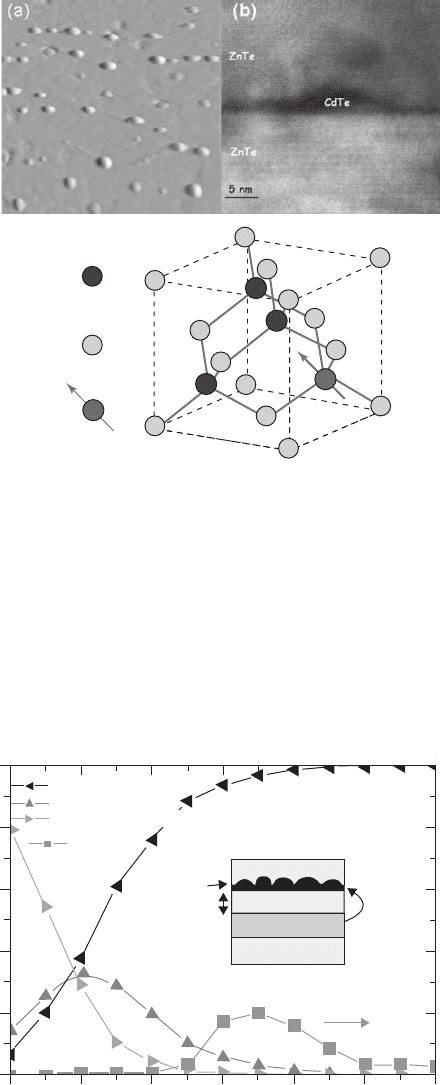
452 Handbook of Self Assembled Semiconductor Nanostructures for Novel Devices in Photonics and Electronics
are randomly distributed over the surface (in plane) and that Mn ions segregate into the ZnTe
spacer (growth direction). For every carrier in the QDs, the value of the interaction between Mn
ions and the electron (hole) confi ned in the QD is calculated using the wave function as described
later. If these interactions are such that the energy spacing between two successive emission lines
is larger than the spectral resolution of our optical spectroscopy set-up (50 μ eV), a single Mn ion
is present in the dot and can be detected with a comb of six lines. The maximum probability is
reached when there are four spacer monolayers as shown in Fig. 14.3 (triangle). However, PL
(c)
Cd
Te
Mn
Figure 14.2 (a) AFM image of a CdTe surface deposited on a ZnTe substrate before deposition of a ZnTe capping
layer. (b) High resolution TEM image showing the structure of a CdTe/ZnTe quantum dot. (c) Crystallin structure of
CdTe with the substitution of a Cd atom by a magnetic Mn atom.
1.0
0.8
0.4
0.6
0.2
0.0
2468
10
12 14
0.00
0.02
0.04
Probability of QD with only one Mn detectable
0.06
ZnTe
h
0 Mn
1 single Mn
CdTe QDs
ZnMnTe
ZnTe spacer
ZnTe capping
0.08
0.10
Mn ions
segregation
h: number of spacer MLs
Probability of QD with Mn
Many Mns (2)
1 Mn
detectable
Figure 14.3 Random simulation of the incorporation of Mn ions into the dot as a function of the number of spacer
monolayers. The maximum of single Mn QDs is reached (square) around 9 ML. The inset is a sample cross-section
profi le.
CH014-I046325.indd 452CH014-I046325.indd 452 6/27/2008 4:29:47 PM6/27/2008 4:29:47 PM
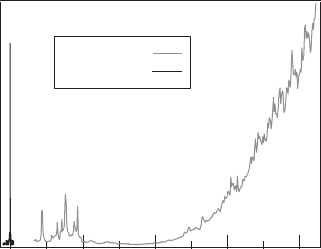
Probing and Controlling the Spin State of Single Magnetic Atoms in an Individual Quantum Dot 453
lines are detected only if no other Mn is close to the QD, i.e. if the interaction between all other
Mn and the exciton does not induce an energy spacing above 20 μ eV. With this additional condi-
tion the optimal probability to detect one single Mn ion is reached for a spacer thickness of 9 ML
(square on Fig. 14.3 ). Moreover, this probability is now very low (see the right scale on Fig. 14.3 )
which shows the limit of random incorporation of Mn ions. Such results guide us effi ciently in our
approach to grow QDs doped with a single Mn ion.
14.3 Optical probing of the spin state of a single magnetic atom in a QD
14.3.1 Confi ned carriers–Mn exchange interaction
Microspectroscopy was used to study the magneto-optical properties of individual CdTe/ZnTe
QDs. The low temperature (5 K) photoluminescence (PL) of single QDs is excited with the
514.5 nm line of an argon laser or a tunable dye laser and collected through a large numerical-
aperture objective and aluminium shadow masks with 0.5–1.0 m apertures. The experiments are
carried out in the backward geometry with the propagation direction of the incident and emitted
light parallel to the [001] growth axis. Superconductive coils are used to apply a magnetic fi eld
up to 11 T in Voigt or Faraday confi guration. The PL is then dispersed by a 2 m double monochro-
mator and detected by a nitrogen-cooled Si charged-coupled device camera or an Si avalanche
photodiode. Typical photoluminescence and excitation spectra of an exciton in a single CdTe/
ZnTe QD are shown on Fig. 14.4 .
PL intensity (arb. units)
21202080204020001960
Energy (meV)
Exciton PLE
Exciton PL
Figure. 14.4 Photoluminescence and photoluminescence excitation spectra of an exciton in a single CdTe/ZnTe
quantum dot.
In Fig. 14.5 , PL spectra of an individual Mn-doped QD are compared to those of a non-magnetic
CdTe/ZnTe reference sample. In non-magnetic samples, narrow PL peaks (limited by the spec-
trometer resolution of about 50 μ eV) can be resolved, each attributed to the recombination of a
single electron–hole pair in a single QD. The emission of neutral QDs is split by the e–h exchange
interaction and usually a linearly polarized doublet is observed [56] . On the other hand, most
of the individual emission peaks of magnetic single QDs are characterized by a rather large line-
width of about 0.5 meV. For some of these QDs, a fi ne structure can be resolved and six emis-
sion lines are clearly observed at zero magnetic fi eld. The measured splitting changes from dot to
dot. This fi ne structure splitting as well as the broadening is obviously related to the infl uence of
the magnetic ions located within the spatial extent of the exciton wave function. The broadening
observed in magnetic QDs has been attributed by Bacher et al. to the magnetic fl uctuations of the
spin projection of a large number of Mn spins interacting with the confi ned exciton [23] . In the
low concentration Mn-doped samples, the observation of a fi ne structure shows that the QD exci-
ton interacts with a single Mn spin. In time-averaged experiments, the statistical fl uctuations of a
CH014-I046325.indd 453CH014-I046325.indd 453 6/27/2008 4:29:48 PM6/27/2008 4:29:48 PM
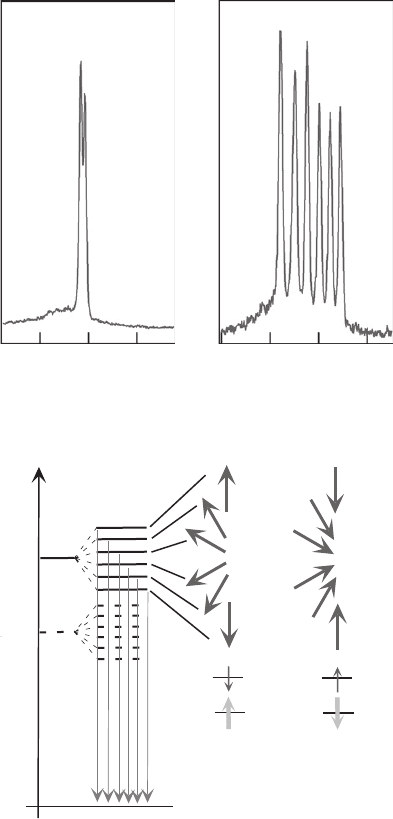
454 Handbook of Self Assembled Semiconductor Nanostructures for Novel Devices in Photonics and Electronics
single Mn spin ( S 5/2) can be described in terms of populations of its six spin states quantized
along the direction normal to the QD plane. The exchange interaction of the confi ned exciton
with the Mn atom shifts its energy depending on the Mn spin projection, resulting in the observa-
tion of six emission lines.
QDs doped with single Mn atoms were considered theoretically in the case of spherical nano-
crystals with a strong confi nement [26] . The eigenstates resulting from the exchange coupling
between the exciton and the magnetic ion were obtained by a combination of the electron, hole
and Mn magnetic moments. In fl at self-assembled QDs with a relatively weak confi nement, the
bi-axial strains in the plane of the QD lift the degeneracy of the hole spin projections (heavy-hole/
light-hole splitting). In a fi rst approximation, this system can be described by a heavy-hole
(a)
2098 2099 2100
Energy (meV)
PL intensity (arb. units)
2085 2086
2087
2088
Energy (meV)
PL intensity (arb. units)
(b)
J
z
1
J
z
2
X MnX
J
z
1 J
z
1
E
S
z
5/2
3/2
1/2
1/2
3/2
5/2
S
z
5/2
3/2
1/2
1/2
3/2
5/2
Mn
(c)
Figure 14.5 Low temperature ( T 5 K) PL spectra obtained at B 0 T for an individual CdTe/ZnTe QD (a) and
a Mn-doped QD (b). (c) Scheme of the energy levels of the Mn–exciton coupled system at zero magnetic fi eld. The
exciton–Mn exchange interaction shifts the energy of the exciton depending on the S
z
component of the Mn spin
projection.
CH014-I046325.indd 454CH014-I046325.indd 454 6/27/2008 4:29:49 PM6/27/2008 4:29:49 PM

Probing and Controlling the Spin State of Single Magnetic Atoms in an Individual Quantum Dot 455
exciton confi ned in a symmetric QD, in interaction with the six spin projections of the manga-
nese ion [52] . The spin interaction part of the Hamiltonian is given by:
HISIjSIj
int e h eh
σσ
(14.2)
where I
e
( I
h
) is the Mn–electron (–hole) exchange integral, I
eh
the electron–hole exchange interac-
tion and σ ( j , S) the magnetic moment of the electron (hole, Mn). The initial states of the optical
transitions are obtained from the diagonalization of the spin Hamiltonian and Zeeman Hamiltonian
in the subspace of the heavy-hole exciton and Mn spin components 1/2
e
3/2
h
S
z
Mn
, with
S
z
5/2, 3/2, 1/2. Since the dipolar interaction operator does not affect the Mn d electrons,
the fi nal states involve only the Mn states S
z
Mn
with the same spin component [4] .
In this framework, at zero magnetic fi eld, the QD emission presents a fi ne structure composed
of six doubly degenerate transitions roughly equally spaced in energy. The lower energy bright
states, 1 / 2
e
3 / 2
h
5 / 2
Mn
and 1 / 2
e
3 / 2
h
5 / 2
Mn
are characterized by an anti-
ferromagnetic coupling between the hole and the Mn atom. The following states are associated
with the Mn spin projections: S
z
3 / 2, 1 / 2 until the higher energy states 1 / 2
e
3 /
2
h
5 / 2
Mn
and 1 / 2
e
3 / 2
h
5 / 2
Mn
corresponding to ferromagnetically coupled hole and
manganese. In this simple model the zero fi eld splitting
δ
Mn e h
II
1
2
3()
depends only on the
exchange integrals I
e
and I
h
and is thus related to the position of the Mn atom within the exciton
wave function.
When an external magnetic fi eld is applied in the Faraday geometry ( Fig. 14.6 ), each PL
peak is further split and 12 lines are observed, six in each circular polarization. As presented in
Fig. 14.7 , if the Zeeman effect of the Mn states is identical in the initial and fi nal states of the
optical transitions then the six lines in a given polarization follow the Zeeman and diamagnetic
shift of the exciton, as in a non-magnetic QD. The parallel evolution of six lines is perturbed
around 7 T in σ polarization by anticrossings observed for fi ve of the lines. In addition, as the
magnetic fi eld increases, one line in each circular polarization increases in intensity and progres-
sively dominates the others.
The electron–Mn part of the interaction Hamiltonian I
e
( σ S ) couples the dark ( J
z
2) and
bright ( J
z
1) heavy-hole exciton states. This coupling corresponds to a simultaneous electron
and Mn spin fl ip changing a bright exciton into a dark exciton. Because of the strain-induced
splitting of light-hole and heavy-hole levels, a similar Mn–hole spin fl ip scattering is not allowed.
The electron–Mn spin fl ip is enhanced as the corresponding levels of bright and dark excitons are
brought into coincidence by the Zeeman effect. An anticrossing is observed around 7 T for fi ve
of the bright states in σ polarization (experiment: Fig. 14.6 and theory: Fig. 14.7 ). It induces
a transfer of oscillator strength to the dark states. In agreement with the experimental results,
in the calculations the lower energy state in σ polarization ( 1 / 2
e
3/2
h
5/2)
Mn
does not
present any anticrossing. In this spin confi guration, both the electron and the Mn atom have
maximum spin projection and a spin fl ip is not possible.
The minimum energy splitting at the anticrossing is directly related to the electron–Mn
exchange integral I
e
. For instance, the splitting measured for the higher energy line in σ polari-
zation ( Fig. 14.6 ), Δ E 1 5 0 μ eV gives I
e
7 0 μ eV. From the overall splitting measured at zero
fi eld (1.3 meV) and with this value of I
e
, we obtain I
h
150 μ eV. These values are in good
agreement with values estimated from a modelling of the QD confi nement by a square quantum
well in the growth direction and a truncated parabolic potential in the QD plane. With a quan-
tum well thickness L
z
3 nm and a Gaussian wave function characterized by an in-plane locali-
zation parameter ξ 5 nm we obtain I
e
6 5 μ eV for an Mn atom placed at the centre of the QD.
However, the ratio of the exchange integral, (3 I
h
)/ I
e
6, for the QD presented in Fig. 14.6 ,
does not directly refl ect the ratio of the sp–d exchange constants β / α 4 measured in bulk
CdMnTe alloys [29] . Such deviation likely comes from the difference in the electron–Mn and
hole–Mn overlap expected from the difference in the electron and hole confi nement length but
it could also be due to a change of the exchange parameters induced by the confi nement [57] .
A dispersion of the zero fi eld energy splitting observed from dot to dot is then due to a variation
of the Mn–exciton overlap for different QDs. However, the spin Hamiltonian (2) does not repro-
duce the observed non-uniform zero fi eld splitting between consecutive lines ( Fig. 14.5b ). As we
CH014-I046325.indd 455CH014-I046325.indd 455 6/27/2008 4:29:49 PM6/27/2008 4:29:49 PM
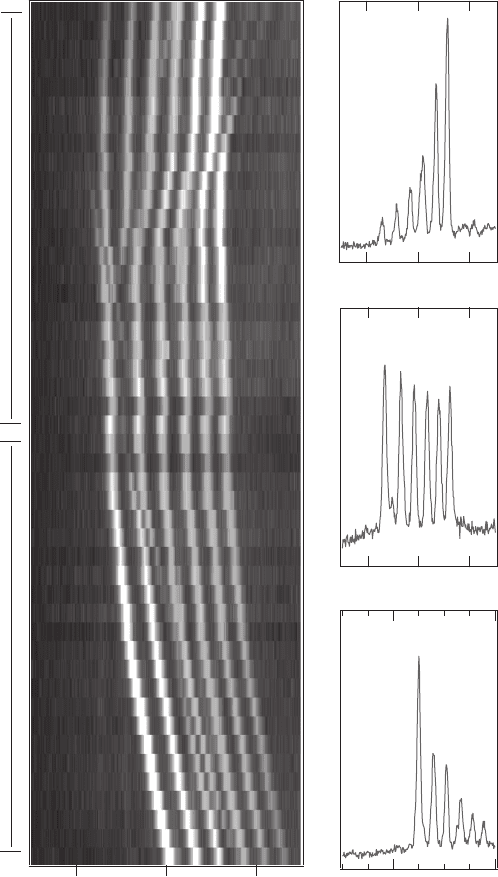
456 Handbook of Self Assembled Semiconductor Nanostructures for Novel Devices in Photonics and Electronics
will see in the following, a more accurate model has to take into account the full valence band
structure and the heavy-hole/light-hole mixing.
14.3.2 The exciton as a probe of the Mn spin state
As illustrated in Fig. 14.6 , the relative intensities of the six emission lines observed in each cir-
cular polarization depends strongly on the applied magnetic fi eld. The emission intensity, which
is almost equally distributed over the six emission lines at zero fi eld, is concentrated on the high
203920382037
Energy (meV)
σ−
σ+
PL
203920382037
Energy (meV)
0T
PL
2039.52037.5
Energy (meV)
σ
11 T
PL
203920382037
Energy (meV)
11 T
σ−
11 T
11 T
0T
0T
Figure 14.6 Magnetic fi eld dependence of the emission of an Mn-doped QD recorded in σ and σ polarization.
Anticrossing of the bright and dark states appears around 7 T in σ polarization.
CH014-I046325.indd 456CH014-I046325.indd 456 6/27/2008 4:29:50 PM6/27/2008 4:29:50 PM
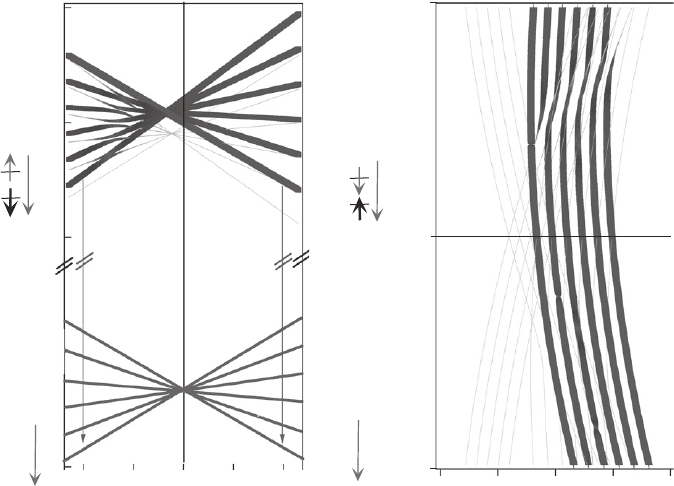
Probing and Controlling the Spin State of Single Magnetic Atoms in an Individual Quantum Dot 457
energy line for the σ emission and on the low energy line for the σ emission at high magnetic
fi eld. As the magnetic fi eld increases, the Mn atom is progressively polarized. In time-averaged
experiments, the probability of observing the recombination of the bright excitons coupled with
the S
z
5/2 spin projection is then enhanced. Two states dominate the spectra: 1/2
e
3 /
2
h
5/2
Mn
in the low-energy side of the σ emission and 1/2
e
3 / 2
h
5 / 2
Mn
in the
high-energy side of the σ polarization. Changing the temperature of the Mn ion will affect the
distribution of the exciton emission intensities. The PL of the exciton is then a direct probe of
the magnetic state of the Mn ion.
14.3.3 Exciton–Mn thermalization process
The effective temperature of the manganese ion in the presence of the exciton, T
Mn
, is found to
depend of course on the lattice temperature but also on the laser excitation density ( Fig. 14.8 ).
For a fi xed temperature and a fi xed magnetic fi eld, the asymmetry observed in the emission inten-
sity distribution progressively disappears as the excitation intensity is increased ( Fig. 14.8a ). The
variation of T
Mn
deduced from the emission rates is presented in the inset of Fig. 14.8c (7 T) and
Fig. 14.8d (0 T) as a function of the excitation density. A similar excitation intensity dependence
of T
Mn
was previously observed in DMS quantum wells and was attributed to the heating of the
Mn
2
ions through their spin–spin coupling with the photo-created carriers [58] . The photo-
carriers have excess energy. Via spin–fl ip exchange scattering they pass their energy to the Mn
2
ions and elevate their spin temperature. The energy fl ux from the Mn to the lattice, determined
by the spin lattice relaxation, will tend to dissipate this excess energy. Under steady-state photo-
excitation, the resulting temperature of the magnetic ions T
Mn
exceeds the lattice temperature.
The effect of this spin–spin coupling is strongly enhanced in our system since the isolated Mn
2
ion is only weakly coupled to the lattice and hardly thermalized with the phonon bath [59] .
e
h
Mn
Mn
(a)
5
0
5
0 T
11 T
11 T
−
e
h
Mn
Mn
(b)
2 1
Ener
g
y (meV)
0
12
0
551010
B (T)
Energy (meV)
Figure 14.7 (a) Scheme of the energy levels of the initial and fi nal state involved in the optical transitions of a
quantum dot containing an Mn atom. (b) Modellization of the optical transition obtained from the diagonalization
of an effective spin Hamiltonian including the e–h exchange interaction, the exciton–Mn exchange interaction, the
Zeeman and the diamagnetic energies. The contribution of the dark states appears in green.
CH014-I046325.indd 457CH014-I046325.indd 457 6/27/2008 4:29:51 PM6/27/2008 4:29:51 PM
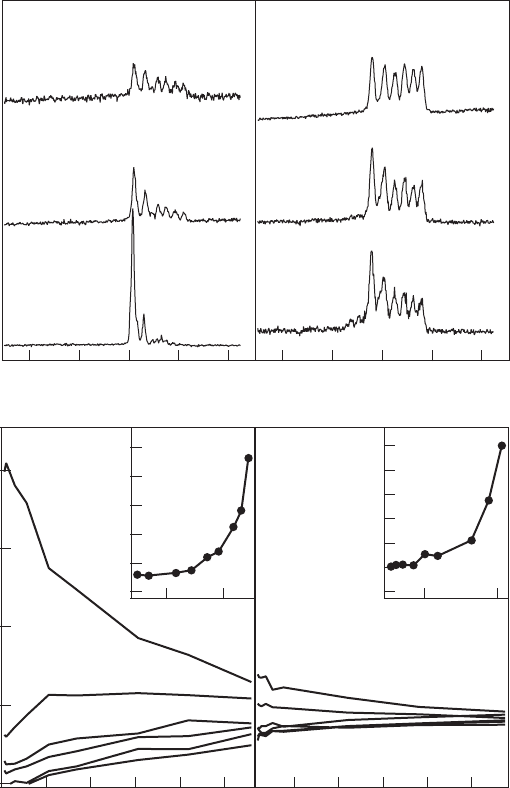
458 Handbook of Self Assembled Semiconductor Nanostructures for Novel Devices in Photonics and Electronics
Under non-resonant excitation, the injection of an exciton changes the spin distribution of the
magnetic ion. As illustrated in Fig. 14.8b , at 0 T and at low excitation intensity, an asymmetry
is observed in the emission intensity distribution. This polarization shows that a spin fl ip of the
exciton–Mn system can occur during the lifetime of the exciton. The exchange interaction with
the exciton acts as an effective magnetic fi eld which splits the Mn
2
levels in zero applied fi eld,
allowing a progressive polarization of its spin distribution.
Resonant excitation of electron–hole pairs directly in the QD limits the exciton–Mn spin relax-
ation [75] . This is illustrated in Fig. 14.9b and c where the emission intensity of the ground state
of an Mn-doped QD is presented as a function of the detection energy when the laser excitation
energy is scanned through the resonant absorption of an excited state identifi ed in a PLE spec-
tra ( Fig 14.9a ). This excitation energy scan reveals that the intensity distribution of the emission
20392038203720362035
Energy (meV)
T 5 K, B 7 T,
σ
15
μ
W
150
μ
W
280
μ
W
Norm PL intensity (arb. units)
20392038203720362035
Energy (meV)
T 5 K, B 0 T
3
μ
W
12
μ
W
110
μ
W
60
50
40
30
20
10
0
T
Mn
10 100
Exc. Int. (
μ
W)
10080604020
Excitation intensity (
μ
W)
(d)
0.8
0.6
0.4
0.2
0.0
25020015010050
Excitation intensity (
μ
W)
(c)
Emission rate
50
40
30
20
10
0
T
Mn
10 100
Exc. Int. (μW)
(a) (b)
Figure 14.8 (a) Normalized PL (PL spectra divided by the total integrated intensity) in σ polarization versus
excitation intensity for a fi xed temperature (5 K) and magnetic fi eld (7 T). (b) Excitation intensity dependence of the
zero magnetic fi eld emission of a single Mn-doped QD for a fi xed lattice temperature T 5 K. (c) and (d) Extracted
emission rates of each PL line as a function of the excitation intensity at 7 T (c) and 0 T (d). The inset plots the
extracted Mn effective temperature.
CH014-I046325.indd 458CH014-I046325.indd 458 6/27/2008 4:29:52 PM6/27/2008 4:29:52 PM
